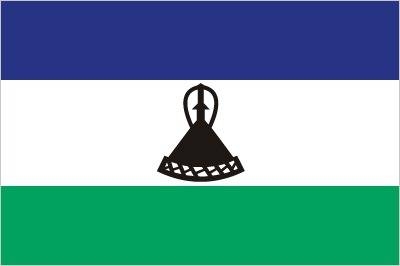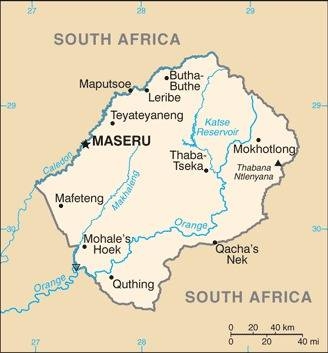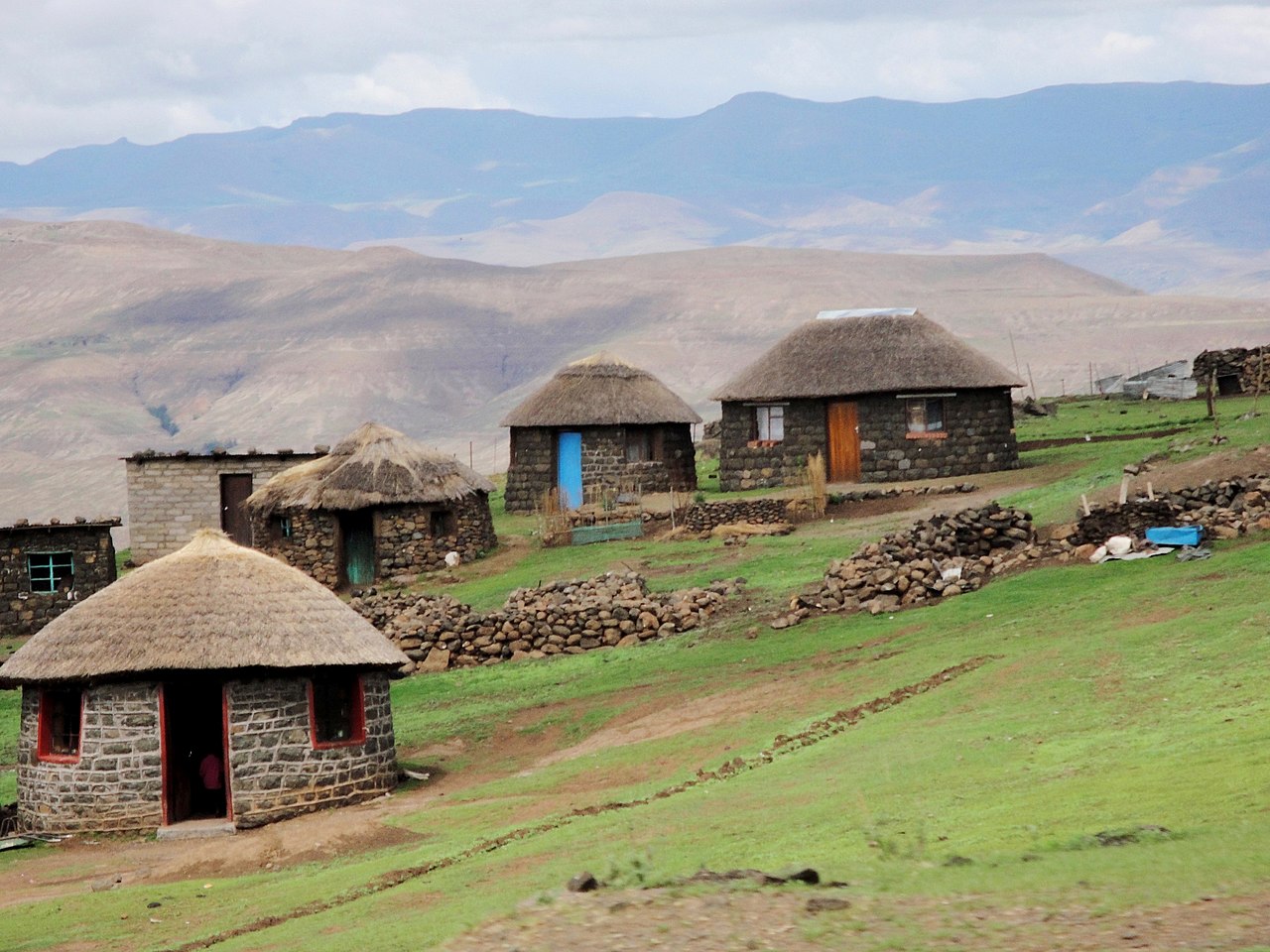203 Lesotho

Three horizontal stripes of blue (top), white, and green in the proportions of 3:4:3. The colors represent rain, peace, and prosperity respectively. Centered in the white stripe is a black Basotho hat representing the indigenous people. The flag was unfurled in October 2006 to celebrate 40 years of independence.
Flag courtesy of the CIA World Factbook

Map courtesy of the CIA World Factbook

Lesotho mountain village
Government
According to Britannica, a constitution was written when Lesotho became independent in 1966, but it was suspended in 1970 by Chief Leabua Jonathan, then prime minister, when it appeared that the opposition party would prevail in the country’s first post independence elections. A new constitution, approved by a constituent assembly in July 1991, was not promulgated until the March 1993 general elections. Lesotho is a constitutional monarchy, with the king as the head of state. The prime minister serves as the head of government and head of the armed forces. The bicameral parliament consists of an elected National Assembly and an appointed Senate. The 120 members of the National Assembly are elected to five-year terms, 80 directly, 40 proportionally, while the Senate consists of 22 traditional chiefs and 11 members chosen by the king. The king himself does not hold executive authority and is instead a national symbol; executive power rests with the cabinet, which is led by the prime minister. Political parties were dissolved in 1986 but reauthorized in 1991.
Lesotho is divided into 10 administrative districts, each of which is under the direction of a district council, headed by an administrator. The subdistrict tier of local government is administered through community and municipal councils. District council members are indirectly elected by the community and municipal councils within the district, while community and municipal council members are directly elected by their constituents. Traditional chiefs are also included in district, community, and municipal councils.
The legal system is based on Roman-Dutch law, with elements of British and customary law also playing a role. There are local and central courts, judicial commissioners’ courts, subordinate courts, and a court of appeal, with the High Court as the superior court of record. Magistrates’ courts exist in the districts. Lesotho maintains only a small defense force and relies on South Africa for its external security.
Under customary law, women cannot inherit land. When a family does not have a son to inherit the land, it reverts back to the chief. This practice was amended by the 1979 Land Act to allow women the right to remain on the property should their husbands die before them. Because of the nature of the migratory work patterns of men, women are increasingly becoming the heads of households, but the law has been slow to acknowledge this fact. Women have been elected to the National Assembly, but they constitute only a small minority of the membership, despite effort to increase the participation of women in politics. However, in the country’s first local government elections, held in 2005, slightly more than half of the councillors elected were women.
Department of Civil Aviation (CAA)
The mission of the department of Civil Aviation (CAA) is “to provide for the control, regulation and development of aviation in Lesotho and for other matters incidental thereto and to give effect to the Chicago Convention and the Transit Agreement” (Aviation Act, 1975. ACT NO. 32 OF 1975 p.86).
Airspace
SkyVector – Google Maps – ADS-B Exchange
ICAO countries publish an Aeronautical Information Publication (AIP). This document is divided into three parts: General (GEN), En Route (ENR) and Aerodromes (AD). ENR 1.4 details the types of airspace classes they chose to adopt from classes A through G. Lesotho AIP
Drone Regulations
None found by the author.
However, should you, the reader, happen to stumble across something to the contrary, please email the author at FISHE5CA@erau.edu and you may be mentioned in the ACKNOWLEDGEMENTS section of this book by way of thanks for contributing to this free eBook!
Advanced Air Mobility (AAM) Regulations & Policies
None found by the author.
However, should you, the reader, happen to stumble across something to the contrary, please email the author at FISHE5CA@erau.edu and you may be mentioned in the ACKNOWLEDGEMENTS section of this book by way of thanks for contributing to this free eBook!
Advanced Air Mobility (AAM) News
None found by the author.
However, should you, the reader, happen to stumble across something to the contrary, please email the author at FISHE5CA@erau.edu and you may be mentioned in the ACKNOWLEDGEMENTS section of this book by way of thanks for contributing to this free eBook!
Short Essay Questions
Scenario-Based Question
You have been hired by a Drone Startup Company. Your boss has immediately assigned this job to you.
They need you to prepare a one-page memo detailing the legalities of using a drone to film the countryside in Lesotho, pictured above.
They need you to mention any national laws and local ordinances.
They specifically want to know what airspace (insert pictures) you will be operating in and whether or not you need an airspace authorization.
Does it matter whether or not you are a citizen of the country?
Lastly, there is a bonus for you if, as you scroll through this chapter, you find any typos or broken links!
Short Essay Questions
- What are the drone categories?
- How is registration addressed?
- How is remote ID addressed?
- What are the model aircraft rules?
- What are the commercial drone rules?
- Are there waivers or exemptions to the rules? If so, for what?
- Would you share a link to an interactive airspace map?
- How is BVLOS addressed?
- How can you fly drones at night?
- How can you fly drones over people?
- Where do you find drone NOTAMs?
- What are the rules for drone maintenance?
- What are the rules for an SMS program?
- What are some unique rules not mentioned above?
- What are the C-UAS rules?
- What are the AAM rules?

